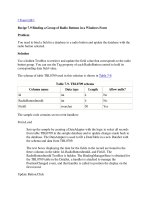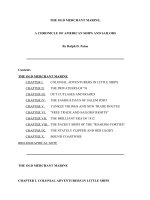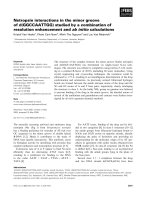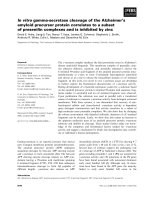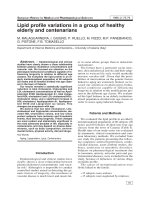The Innovators How A Group Of Hackers, Geniuses, And Geeks Created The Digital Revolution
Bạn đang xem bản rút gọn của tài liệu. Xem và tải ngay bản đầy đủ của tài liệu tại đây (13 MB, 864 trang )
THE
INNOVATORS
ALSO BY WALTER ISAACSON
Steve Jobs
American Sketches
Einstein: His Life and Universe
A Benjamin Franklin Reader
Benjamin Franklin: An American Life
Kissinger: A Biography
The Wise Men: Six Friends and the World They Made (with Evan
Thomas)
Pro and Con
Free Download ebook:
HOW A GROUP OF HACKERS, GENIUSES, AND GEEKS
CREATED THE DIGITAL REVOLUTION
First published in Great Britain by Simon & Schuster UK Ltd, 2014
A CBS COMPANY
Copyright © 2014 by Walter Isaacson
This book is copyright under the Berne Convention.
No reproduction without permission.
All rights reserved.
The right of Walter Isaacson to be identified as the author of this work has been asserted by him in accordance with sections 77
and 78 of the Copyright, Designs and Patents Act, 1988.
Simon & Schuster UK Ltd
1st Floor
222 Gray’s Inn Road
London WC1X 8HB
www.simonandschuster.co.uk
Simon & Schuster Australia, Sydney
Simon & Schuster India, New Delhi
A CIP catalogue record for this book is available from the British Library
Excerpts from “All Watched Over by Machines of Loving Grace” from The Pill Versus the Springhill Mine Disaster by Richard
Brautigan. Copyright © 1968 by Richard Brautigan. Reproduced by permission of Houghton Mifflin Harcourt Publishing
Company. All rights reserved.
Photo research and editing by Laura Wyss, Wyssphoto, Inc., with the assistance of Elizabeth Seramur, Amy Hikida, and Emily
Vinson, and by Jonathan Cox.
Interior design by Ruth Lee-Mui
ISBN: 978-1-47113-879-9
Ebook: 978-1-47113-881-2
The author and publishers have made all reasonable efforts to contact copyright-holders for permission, and apologise for any
omissions or errors in the form of credits given. Corrections may be made to future printings.
Printed and bound by CPI Group (UK) Ltd, Croydon, CR0 4YY
CONTENTS
Illustrated Timeline
Introduction
CHAPTER 1
Ada, Countess of Lovelace
CHAPTER 2
The Computer
CHAPTER 3
Programming
CHAPTER 4
The Transistor
CHAPTER 5
The Microchip
CHAPTER 6
Video Games
CHAPTER 7
The Internet
CHAPTER 8
The Personal Computer
CHAPTER 9
Software
CHAPTER 10
Online
CHAPTER 11
The Web
CHAPTER 12
Ada Forever
Acknowledgments
Notes
Photo Credits
Index
THE
INNOVATORS
1800
1843
Ada, Countess of Lovelace, publishes “Notes” on Babbage’s Analytical
Engine.
1847
George Boole creates a system using algebra for logical reasoning.
1890
The census is tabulated with Herman Hollerith’s punch-card machines.
1931
Vannevar Bush devises the Differential Analyzer, an analog
electromechanical computer.
1935
Tommy Flowers pioneers use of vacuum tubes as on-off switches in
circuits.
1937
Alan Turing publishes “On Computable Numbers,” describing a
universal computer.
Claude Shannon describes how circuits of switches can perform tasks
of Boolean algebra.
Bell Labs’ George Stibitz proposes a calculator using an electric circuit.
Howard Aiken proposes construction of large digital computer and
discovers parts of Babbage’s Difference Engine at Harvard.
John Vincent Atanasoff puts together concepts for an electronic
computer during a long December night’s drive.
1938
William Hewlett and David Packard form company in Palo Alto garage.
1939
Atanasoff finishes model of electronic computer with mechanical
storage drums.
Turing arrives at Bletchley Park to work on breaking German codes.
1941
Konrad Zuse completes Z3, a fully functional electromechanical
programmable digital computer.
John Mauchly visits Atanasoff in Iowa, sees computer demonstrated.
1952
1942
Atanasoff completes partly working computer with three hundred
vacuum tubes, leaves for Navy.
1943
Colossus, a vacuum-tube computer to break German codes, is
completed at Bletchley Park.
1944
Harvard Mark I goes into operation.
John von Neumann goes to Penn to work on ENIAC.
1945
Von Neumann writes “First Draft of a Report on the EDVAC”
describing a stored-program computer.
Six women programmers of ENIAC are sent to Aberdeen for training.
Vannevar Bush publishes “As We May Think,” describing personal
computer.
Bush publishes “Science, the Endless Frontier,” proposing government
funding of academic and industrial research.
ENIAC is fully operational.
1947
Transistor invented at Bell Labs.
1950
Turing publishes article describing a test for artificial intelligence.
1952
Grace Hopper develops first computer compiler.
Von Neumann completes modern computer at the Institute for
Advanced Study.
UNIVAC predicts Eisenhower election victory.
1954
1954
Turing commits suicide.
Texas Instruments introduces silicon transistor and helps launch
Regency radio.
1956
Shockley Semiconductor founded.
First artificial intelligence conference.
1957
Robert Noyce, Gordon Moore, and others form Fairchild
Semiconductor.
Russia launches Sputnik.
1958
Advanced Research Projects Agency (ARPA) announced.
Jack Kilby demonstrates integrated circuit, or microchip.
1959
Noyce and Fairchild colleagues independently invent microchip.
1960

